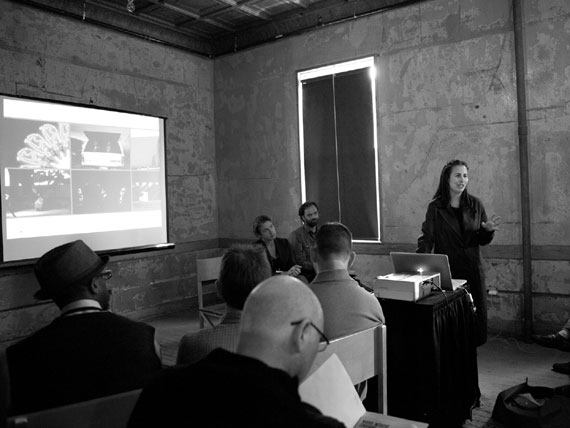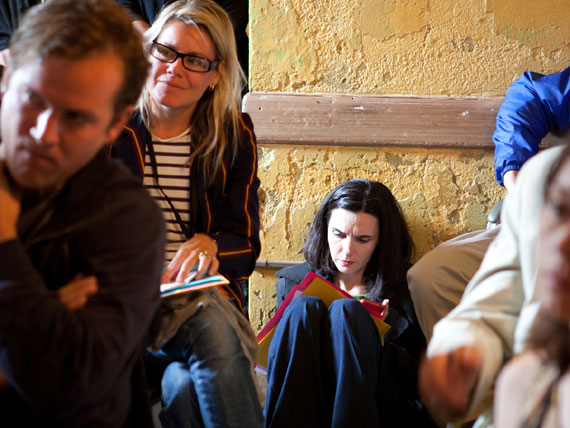Agility Now
In thinking through and beyond the recent economic downturn, we will introduce the session by presenting the varied strategies that have allowed three very different organizations to turn the economic crisis into something of an advantage. How did these organizations expand and contract? How did they renegotiate the relationship between institution and programs? How have these decisions shaped the institutions? How do we define value: the value of our programs, staff, collaborators? How do you define scalability? How do we manage expectations—actual and/or perceived? What are the roles of the Executive Director and the Board?
The session was led by Lauri Firstenberg, LA><ART; Nat May, Space Gallery; and Sylvie Fortin, ArtPapers. An open discussion followed their individual presentations.
Nat May: Getting on the map
“I have a prop for this talk,” said Nat May as he opened Agility Now panel presenting the strategies Space Gallery, LA><ART, and Art Papers followed to turn the recent economic crisis to their advantage. He handed out a black sticker with a list of ten Maine destinations, nine grandly-named small towns and Space. “In 2005, I read a creative economy report that a consultant wrote for the City of Portland. It listed the top ten arts and culture organizations in town. I wanted to make that list. At that time, Space Gallery had a budget of $250,000. Now, our budget is $415,000 and we are opening a brand-new gallery next week.”
How did Space double their budget and finance a major expansion in the midst of the downturn? According to May, their programming remained constant at about 200 events and 15 exhibitions per year. The key change was a mental shift: recognizing and valuing Space’s assets—their facility, their expertise in organizing art events, and their connections in the community—and asking organizations that used their space to cost-share. “We did some tricky math with our Board Treasurer to figure out what it was costing us to say open every day…In the beginning, we felt apologetic about asking organizations to contribute, but asking people to share costs made a huge difference,” he said. They also analyzed the opportunity costs of the different types of events they hosted, and looked for a balance that would maximize their earned income from a mix of sources including ticket sales and a small bar. A concerted effort to reach out to other organizations made Space a “go-to” place for people who want to put on events and social activities for their organization; the Space mailing list reached new communities as other organizations brought people in.
They were able to add a low-cost volunteer coordinator position by working with Americorps personnel, which served as a bridge until the organization was able to add a paid volunteer coordinator position this past year. “Giving more individual attention to the volunteers got them more involved,” May said, “and almost everything we do has a volunteer component.”
The third point May emphasized was the need for shared long-term vision. While May saw opportunities for expansion, he didn’t mention them until Board members began discussing the limits of their facilities. Then things moved quickly. The Board took on a fundraising challenge to raise $75,000 in a month; within three weeks they received $145,000 from a handful of “second-degree” contributors who had noticed their progress as an organization. “The sign that sticker is based on is about two hours away from where I live,” said May. “Our question was ‘How do we get our name on the map?’. Now we’ve done it.”
Lauri Firstenberg: From panic to partnership
“Panic was my first reaction to the economic downturn,” said Lauri Firstenberg, as she showed an image of LA><ART’s facade, with a mural by Dianna Molzan. “When things shifted in economy, we were about to sign our second five-year lease on our space. I didn’t feel comfortable doing so. We do public projects as well as exhibitions, and my instinct was that the flexibility of doing projects in the community would be appropriate for the times. I didn’t think ‘keep doing what you’re doing’ would be good enough.”
But when she made this proposal to LAX’s Advisory Board, they said no, artists needed a space like LAX more than ever. “We have a big advisory board of arts professionals that convenes once a year. What happens at that meeting guides the mission; we always said we would be responsive to artists’ needs and conditions,” said Firstenberg, “So we focused on the space but tried to pace ourselves programmatically. And some other opportunities began to emerge from the need to keep the space going. We had been talking to friends at the UCLA Hammer Museum for a long time about what a partnership would look like. It was really difficult and took five years to articulate. There’s always an interest in art being independent but I understood that for the patron class in our area, our space is not impressive and our programming is too experimental. Our supporters and our audience are artists. We realized a strategic alliance could be mutually beneficial. For example, they can’t do public art programs due to the problems of negotiating insurance for UCLA. Our curatorial teams could come together to do programs without touching the bureaucracy of UCLA.”
Their first collaboration was a presentation of Joel Kyack’s Superclogger, a disturbing, psychosexual puppet show staged in the back of Kyack’s truck. “People would encounter it on freeway,” said Firstenberg, “It got an enormous amount of attention. It was on the news every day. It wasn’t the context Kyack wanted to be in, but we saw what could happen in growing our public.”
The alliance with Hammer continues to evolve through co-curated projects and an invitational exhibition, “a biennial-like platform that we’re not calling a Biennial,” said Firstenberg. “For the invitational, Kerry Tribe made an installation in our gallery and LA><ART’s billboard became the site of the invitational’s signature image, a still from a video by Fernando Ortega. We’ve discovered we can drive audience to both spaces. Artists work in both venues, and one thousand people will see the work at the Hammer, and another thousand will see it at LA><ART. Artists don’t have to choose…The Hammer experience has been incredible, because I get to work with my favorite colleagues who came out here from New York—we grew up together. There’s no threat of absorption. I think it’s meaningful to people who give money to know they can support us both with a donation to a project. They’re not pulled between one or the other.”
Bringing Hammer programming to LA><Art art allowed the smaller organization to get on a slower schedule, giving Firstenberg time to fundraise and work on a strategic plan. This institution building paid off in May, when the Getty Foundation approached LA><ART about co-directing a performance and public art festival for Pacific Standard Time: Art in L.A. 1945-1980, a series of concurrent exhibitions at museums throughout Southern California highlighting the post-World War II Los Angeles art scene.
The concurrent partnerships with the Getty and the Hammer have LA><ART producing twenty-five projects in twenty-five spaces over the next six months. “We’ve taken on these two things that are much, much bigger than we are,” said Firstenberg. “I believe getting through these will give us the flexibility to get back to on-the-ground programming and public art initiatives, and the track record will also build our credibility with Los Angeles patrons.”
Sylvie Fortin: Refocusing and capitalizing
“I joined Art Papers in 2004,” said Sylvie Fortin. “It was an old publication, puttering along, with a lot of structural and facilities problems. The computers were outdated and would shut down every half-hour while we were trying to edit, for example. The Warhol Initiative stepped in to help us renovate our space and make some strategic investment; we began building an operating reserve. Then the recession hit. Had we not had that period of organizational building provided by the Warhol, Art Papers would be gone.
“When I started,” Fortin continued, “We took a year to redesign and re-conceptualize the magazine, asking questions such as ‘What does it mean if your legacy is that you started as the Art Workers Coalition Newsletter? What does that mean in 2005?’ We relaunched in 2006 and went from distribution in 13 countries to 80 countries. Revenue streams were up. Then boom! The recession. Advertising income disappeared and our major fundraiser, an art auction, dwindled significantly. We had operating deficits two years in a row which drew down our reserve, which had been up to $90,000. In the middle of this, we changed our accounting basis for newsstand sales, which in paper doubled our deficit from $30,000 to $60,000.
“Solid work with our Board was crucial in refocusing, internally and externally. The recession brought an opportunity to renegotiate contracts and cut costs. It allowed us to talk about the staffing structure and the Board in a more open way. We had to ask what we wanted to be when we grew up and what kind of talent was necessary to get there. And we had to talk openly with the Board about what we needed. We took a big hit in 2009, but we worked hard on strategizing a way out. Then we just followed the plan. We ended up with a profit last year, put something back into the reserve, and this year we are tracking well. The lesson I draw from this was always think of yourself and your Board in a dynamic way.
“The thing that changed with this recession is that I now understand and believe we need to capitalize our organizations. When we operate on the edge, we have to exploit each other and the people we are supposed to serve and I don’t want to do that any more. At Art Papers, we want to talk about the social relevance of the arts. But everyday I exploit my staff and 300 writers, because I underpay them. How can I talk about social relevance when the thing I control is based on exploitation? Understanding that, I believe we need to capitalize the organization as one would do in any other field.
“Raising compensation for staff is the tip of the iceberg. In fairness we should simultaneously and proportionately raise the rate for our writers. But a small increment is a huge financial challenge when you’re publishing six times a year in print and publishing online—a small incremental raise for an individual is $100,000 for the organization. We also face challenges in overall capacity. I cannot bring another body into our office right now. Right now we are in Atlanta but our readership is international. What makes sense for our program and fundraising ability? Should the next office be in Atlanta, Dallas, New York, or Istanbul?
“I didn’t mention it yet but it is important that part of reconceptualizing was to move away from thinking of Art Papers as a magazine and focus on its essence of discursive editing. When we started, print was the only platform, but now we have a multiplicity of platforms that include encounter and change constantly. We want to create precision and complementarity in our use of platforms, to create an environment where people can move in between them seamlessly.”
Related Links:
Americorps
UCLA Hammer Museum
Pacific Standard Time at the Getty






